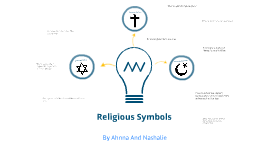Religious Symbols
Transcript: Candles as Symbols of Light Candles are used in religious ceremonies to symbolize divine light and guidance. They represent the presence of Christ and serve as a physical reminder of the light dispelling darkness in spiritual life. Incense and Its Spiritual Implications Incense is often used in worship to signify the prayers of the faithful rising to heaven. Its fragrant smoke not only enhances the sensory experience of worship but also symbolizes sanctity and reverence in rituals. Bread and Wine in Communion Bread and wine are central elements in the Eucharist, symbolizing the body and blood of Christ. This sacrament connects believers with the sacred, representing nourishment of the soul and a communal link among the faithful. Other Important Symbols The Cross Defining Religious Symbols Introduction to Religious Symbols Historical Context of the Cross Religious symbols are visual representations that convey complex ideas and beliefs associated with a particular faith. They can include physical items, gestures, or imagery that evoke spiritual meanings and community identity. Religious symbols serve as powerful representations of faith and beliefs, deeply embedded in the practices of spirituality and worship. Understanding their significance enhances the appreciation of rituals such as those found in Holy Mass. Key symbols such as bread and wine, candles, and incense play essential roles in religious rituals, especially during Holy Mass, each carrying profound significance and historical context. The cross is a profound symbol in Christianity, representing sacrifice, redemption, and faith. It serves as a visual reminder of the crucifixion of Jesus Christ, central to the teachings and beliefs of many Christian denominations. The cross, originally a Roman execution device, transformed into a symbol of hope and salvation after Christ's crucifixion. Early Christians adopted the cross as a symbol of their faith, emphasizing resurrection and eternal life, which led to its prominence in art and architecture across centuries. Key Symbols in Holy Mass Spiritual Significance of the Cross in Mass In Holy Mass, various symbols represent essential aspects of faith. Notable examples include the Cross, which signifies sacrifice and redemption, and elements like bread and wine that symbolize the Eucharist. In Mass, the cross symbolizes the sacrifice of Jesus and is central to the liturgy. It serves as a focal point during worship, reminding congregants of the grace bestowed upon them through Christ's death and resurrection, fostering a profound connection to their faith. Significance in Spiritual Practices SYMBOLE NA MSZY ŚWIĘTEJ Religious symbols play a crucial role in spiritual practices by providing a tangible connection to the divine. They facilitate worship, enhance rituals, and help individuals express their beliefs within a community. „Zstąpiłem bowiem z nieba, nie aby wypełniać wolę swoją, lecz wolę tego, który mnie posłał” (Ew. Jana 6:38). Significance of Fire in Holy Mass The Symbol of Water In Holy Mass, fire is utilized for both practical and symbolic purposes. The use of candles represents Christ as the light of the world, while the altar fire plays a central role during significant rituals, reflecting purification and holiness that elevates the sacredness of the celebration. Water as a Purification Element Water serves as a powerful symbol of purification in many religious traditions, embodying the concepts of cleansing, renewal, and spiritual transformation. Its role in holy rituals underscores its significance in connecting believers to the divine. Fire in Religious Contexts In various cultures, water symbolizes purity and is often used in rituals to cleanse the soul. In Christianity, it represents baptism, washing away sins and signifying rebirth into faith. Fire is often viewed as a representation of the divine across various religions. In Christianity, the Holy Spirit is depicted as fire, particularly during Pentecost, symbolizing empowerment and presence. Similarly, in Hinduism, Agni is the fire god, serving as a mediator between humans and the divine, embodying purification and sacrifice. Role of Water in Holy Mass During Holy Mass, water is mixed with wine to symbolize the unity of Christ's divine and human natures. The use of water in rituals highlights its significance as a purifying and life-giving element in the sacramental life of the Church. The Symbol of Fire Fire serves as a powerful symbol in religious contexts, representing divine presence and transformation. Throughout various faiths, fire is revered for its ability to cleanse, illuminate, and signify the sacred.

















